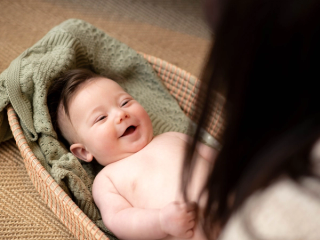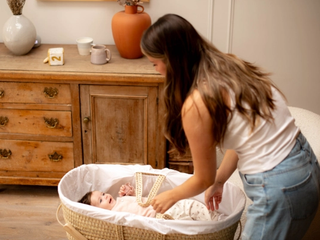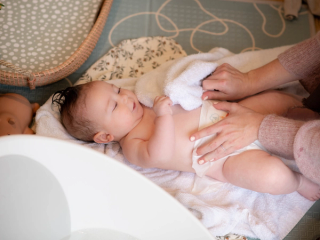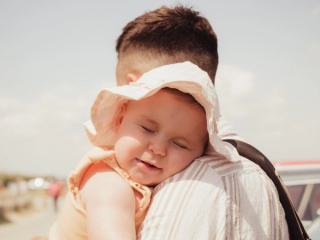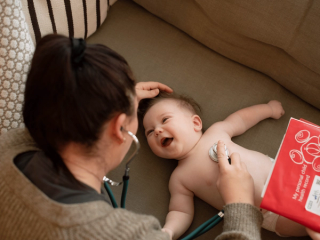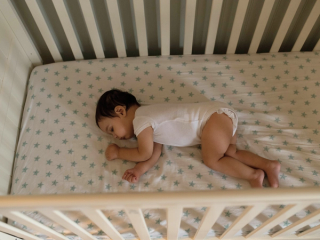
- Home
- Advice Hub
- Newborn
- Essential Newborn Care
- Diagnosing And Managing Childhood Rashes
Diagnosing and managing childhood rashes
Learn how to identify and manage common childhood rashes with simple tips to help care for your little one’s skin and know when to seek medical advice.
Rashes are pretty common in little ones and can occur for several reasons. Whilst they’re usually easy to spot, figuring out what’s causing them and what to do next can be a bit more challenging. This guide is here to help you understand what to look out for and how best to care for your child’s skin.
Types of rashes
Viral rashes
Viral rashes are one of the most common types of rashes in children and often appear alongside other symptoms like a fever, runny nose, or sore throat. They’re usually caused by common viruses such as those that lead to colds. These rashes often look like blotchy red spots commonly affecting most of the body and usually go away on their own within a few days. While they can look worrying, most viral rashes aren’t serious but it’s always a good idea to check with a doctor if you’re unsure or if your child seems unwell.
Allergic rashes
Allergic rashes can happen suddenly and may be triggered by things like certain foods, medications, or other allergens. Food allergies might cause a rash just around the mouth or more widespread skin reactions and sometimes come with other symptoms like tummy troubles or poor growth. Medication related rashes, such as to antibiotics can be widespread and may include a fever. Allergic rashes are often raised, itchy, and can even blister when the skin becomes very inflamed. If you ever suspect an allergic reaction, it’s important to get medical advice right away.
Heat rashes
This common eruption in babies occurs most commonly in hot or humid conditions. This is not always due to weather, it can happen in areas where the skin gets too warm for example, where thick clothing is in contact with the skin, or if thick, greasy creams have been applied. It happens when sweat ducts become blocked or inflamed, causing tiny bumps on the skin in the affected areas, most often in skin folds or on the trunk. These can be itchy and irritating. To help, keep your child cool with loose cotton clothing, cool baths, and gentle skincare products. If the rash doesn’t improve or your child seems unwell, it’s best to check in with a healthcare professional.
Slapped cheek syndrome
Slapped cheek syndrome otherwise known as erythema infectiosum, is caused by Parvovirus B19. This virus causes symptoms such as fever and headache, which are followed by a hot rash affecting the cheeks. The rash can sometimes spread to other areas on the body such as the chest, stomach, arms and thighs. This often has a raised, lace-like appearance and may be itchy. It is a self-limiting illness and resolves on its own, but can be supported with the use of cool compresses to the skin and paracetamol if fever or pain are present.
Eczema/atopic dermatitis
Eczema (also called atopic dermatitis) is a long-term skin condition that comes and goes, and can make your child’s skin very itchy and uncomfortable. It presents as an itchy eruption on the skin, typically on the cheeks and scalp in babies, and more widespread or in the skin folds (like elbows and knees) of older infants and young children. The skin can look red, flaky, or even scaly.
One of the main areas of treatment is to keep the skin well hydrated with emollients. Applying emollient regularly (several times a day or when the skin looks dry) to all skin is important, using bland non-perfumed products is also recommended. If the rash is not improving or is causing ongoing symptoms of itch and irritation, then it's a good idea to see a healthcare professional.
Hand, foot and mouth disease
Hand, foot and mouth disease (HFMD) is a common viral illness that spreads easily between young children. It usually causes small blisters or sores on the hands, feet, bottom, and inside the mouth. Children may also have a mild fever, tummy ache, or feel off their food. Although it can look uncomfortable, HFMD usually gets better on its own with some simple care. Keep your child comfortable with pain relief, offering plenty of fluids, and gently looking after their skin with emollients.
What to look out for if you suspect your child has ‘problem’ skin?
Skin problems are very common in babies and young children. This can be due to several factors, like their delicate skin barrier, family history, the environment, their developing immune system, illnesses, or contact with irritating substances.
Signs of skin issues can include:
- Dryness - seen as flaking or scaling
- Inflammation – you might see changes in skin colour (redder, lighter, or darker) and texture (rough or easily irritated).
- Itching and scratching – babies might not scratch with their hands but may rub the itchy area against clothing, bedding, or other surfaces.
- Sleep disruption – skin discomfort can make it hard for your child to fall asleep or stay asleep, leading to irritability and tiredness.
- Location – skin issues may be limited to one area (like the face) or appear more widely (such as on the trunk, arms, or legs).
- Irritation – often shows up as a mix of dryness, colour changes, and rough or scratched skin.
Tips on how to manage problematic skin in children
- Keep a simple symptom diary - have you noticed any triggers to the rash, anything that makes it better or worse?
- Review all skincare products – check what you’re using during bath time and daily cleansing. Choose products that are fragrance-free, gentle, and labelled for sensitive skin.
- Moisturise regularly – use emollients often, including on irritated areas. A good routine is during nappy changes, morning and evening, and after baths.
- Avoid wipes when possible – cleansing wipes can contain preservatives that irritate sensitive skin. Stick to gentle water-based cleansing when you can.
- Don’t stop bathing – gentle bathing is still important. Use lukewarm (tepid) water and mild, skin-friendly products like HiPP Head to Toe Baby Wash. Always moisturise gently onto damp skin afterwards to lock in hydration.
- Keep skin cool and covered – loose cotton clothing is best, and if your child is scratching or rubbing, try covering hands and feet to protect the skin.
- Hand hygiene matters – regular hand washing helps prevent the spread of infections. Use skin-friendly handwashes, and for older babies or toddlers, fun products like HiPP Kids soft & foamy handwash duck can make it easier.
- Continue care after rashes fade – even after a rash has cleared, skin may peel or feel dry. Keep using moisturiser and non-soap cleansers to support healing.
- Know when to get help – if your child’s skin isn’t improving, is getting worse, or they seem unwell (e.g. with a fever), speak to a healthcare professional.
Most childhood rashes are mild and clear up with simple care, but if your child seems unwell, the rash isn’t improving, or you're ever unsure, it’s always best to check in with a healthcare professional for advice and peace of mind. You can find more information on the NHS website as when to seek immediate/urgent medical help for rashes.
Frequent asked questions on childhood rashes
You should seek immediate medical attention if your child is unwell with a rash and has any of the following symptoms:
- A stiff neck
- if your child is sensitive to light
- Seems confused or not their usual self
- Breathing difficulties
- Skin, lips or tongue appear pale or blue
- Swelling around the mouth or tongue or difficulty swallowing
- The rash looks like small bruises or bleeding under the skin and does not fade when you press a glass against it.
Viral rashes often look like blotchy red spots commonly affecting most of the body and usually go away on their own within a few days.
Common childhood rashes include viral rashes such as chicken pox, hand foot and mouth disease, slapped cheek syndrome. Allergic rashes, ringworm, eczema and heat rashes.
The information in this article is for education purposes and should not replace professional medical advice. Always consult medical professionals/your healthcare provider for diagnosis and treatment.
